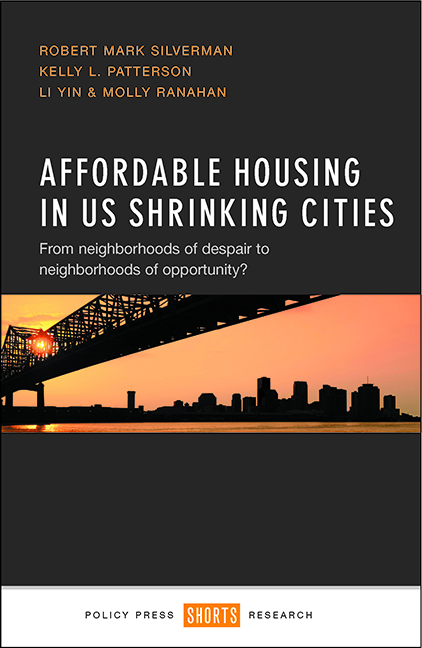 Affordable Housing in US Shrinking Cities
Affordable Housing in US Shrinking Cities Book contents
- Frontmatter
- Contents
- List of tables
- List of figures
- List of acronyms
- About the authors
- Acknowledgments
- Preface
- 1 Social equity and siting affordable housing in shrinking cities
- 2 Present-day Detroit
- 3 Present-day New Orleans
- 4 Present-day Cleveland
- 5 Present-day Pittsburgh
- 6 Present-day Buffalo, New York
- 7 Lessons learned and recommendations for siting affordable housing
- References
- Index
6 - Present-day Buffalo, New York
Published online by Cambridge University Press: 01 September 2022
- Frontmatter
- Contents
- List of tables
- List of figures
- List of acronyms
- About the authors
- Acknowledgments
- Preface
- 1 Social equity and siting affordable housing in shrinking cities
- 2 Present-day Detroit
- 3 Present-day New Orleans
- 4 Present-day Cleveland
- 5 Present-day Pittsburgh
- 6 Present-day Buffalo, New York
- 7 Lessons learned and recommendations for siting affordable housing
- References
- Index
Summary
Introduction
This chapter examines Buffalo’s urban revitalization strategies. It begins with a discussion of the structural causes of the city’s population decline. This discussion highlights how changes in production, transportation, and energy systems contributed to the Buffalo region’s decline during the postwar period. One byproduct of shrinking in Buffalo was the intensification of segregation in institutions like the public schools and urban housing markets. The nexus between shrinking and persistent racial segregation is discussed in this context. After reviewing the foundations for sustained shrinking and inequality in Buffalo, data are presented which show the extent to which segregation persists in the metropolitan area.
Following the observations of regional population and housing characteristics, we examine conditions in the area of Buffalo where eds and meds revitalization strategies have been adopted. The neighborhood characteristics where anchor-based strategies have been applied are contrasted with the rest of the city. This analysis includes an examination of the composition of Department of Housing and Urban Development (HUD)-subsidized housing in areas slated for eds and meds revitalization. We chose this focus in order to gain insights into the degree to which the preservation and expansion of affordable housing was factored into anchor-based revitalization strategies. This topic is explored in greater detail in the final section of the chapter.
Buffalo in the wake of sustained shrinking
Where things stand in Buffalo
During the late 19th and early 20th centuries, Buffalo was a center for shipping and manufacturing. The city’s status as an industrial hub was due to several locational advantages (Crandall 2002; Hollander and Cahill 2014). Buffalo was situated where the Erie Canal opened into the Great Lakes. This made the city an ideal location for a number of economic pursuits tied to the storage, milling, and transportation of grain. Buffalo also had direct access to a cluster of hydroelectric generating plants in Niagara Falls. These plants fed industry with a virtually unlimited supply of low-cost energy. As a result, a diversified manufacturing sector emerged in the city. In addition to grain and food products, Buffalo was a major producer of steel, metal products, automobile components, durable goods, and chemicals.
- Type
- Chapter
- Information
- Affordable Housing in US Shrinking CitiesFrom Neighborhoods of Despair to Neighborhoods of Opportunity?, pp. 119 - 146Publisher: Bristol University PressPrint publication year: 2016


